instrument panel Citroen JUMPER DAG 2008.5 2.G User Guide
[x] Cancel search | Manufacturer: CITROEN, Model Year: 2008.5, Model line: JUMPER DAG, Model: Citroen JUMPER DAG 2008.5 2.GPages: 163, PDF Size: 2.56 MB
Page 72 of 163
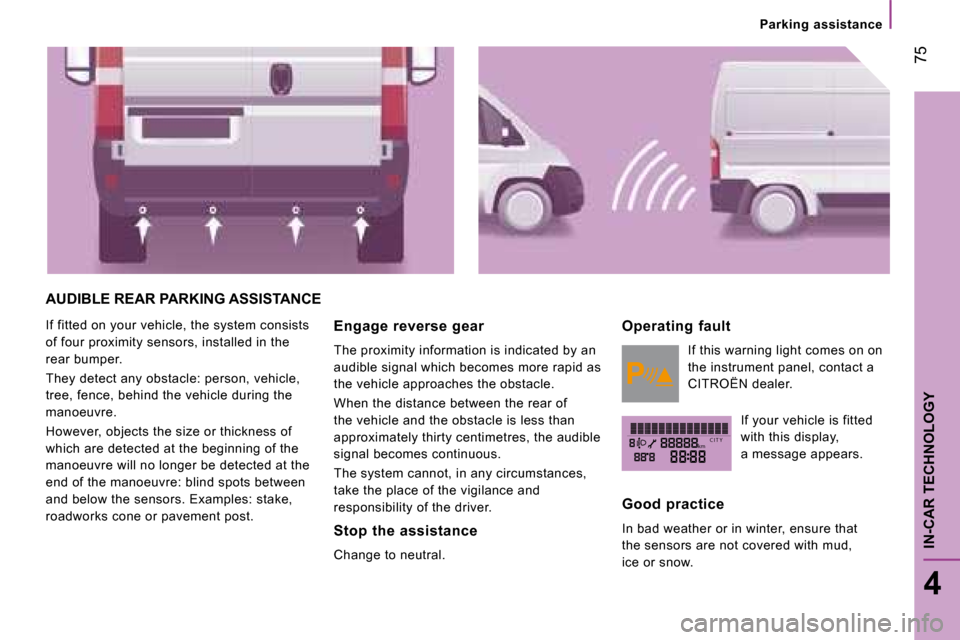
kmC I T Y
75
4
IN-CAR TECHNOLOGY
Parking assistance
AUDIBLE REAR PARKING ASSISTANCE
If fitted on your vehicle, the system consists
of four proximity sensors, installed in the
rear bumper.
They detect any obstacle: person, vehicle,
tree, fence, behind the vehicle during the
manoeuvre.
However, objects the size or thickness of
which are detected at the beginning of the
manoeuvre will no longer be detected at the
end of the manoeuvre: blind spots between
and below the sensors. Examples: stake,
roadworks cone or pavement post.
Engage reverse gear
The proximity information is indicated by an
audible signal which becomes more rapid as
the vehicle approaches the obstacle.
When the distance between the rear of
the vehicle and the obstacle is less than
approximately thirty centimetres, the audible
signal becomes continuous.
The system cannot, in any circumstances,
take the place of the vigilance and
responsibility of the driver.
Stop the assistance
Change to neutral. Operating fault
If this warning light comes on on
the instrument panel, contact a
CITROËN dealer.
If your vehicle is fitted
with this display,
a message appears.
Good practice
In bad weather or in winter, ensure that
the sensors are not covered with mud,
ice or snow.
Page 75 of 163
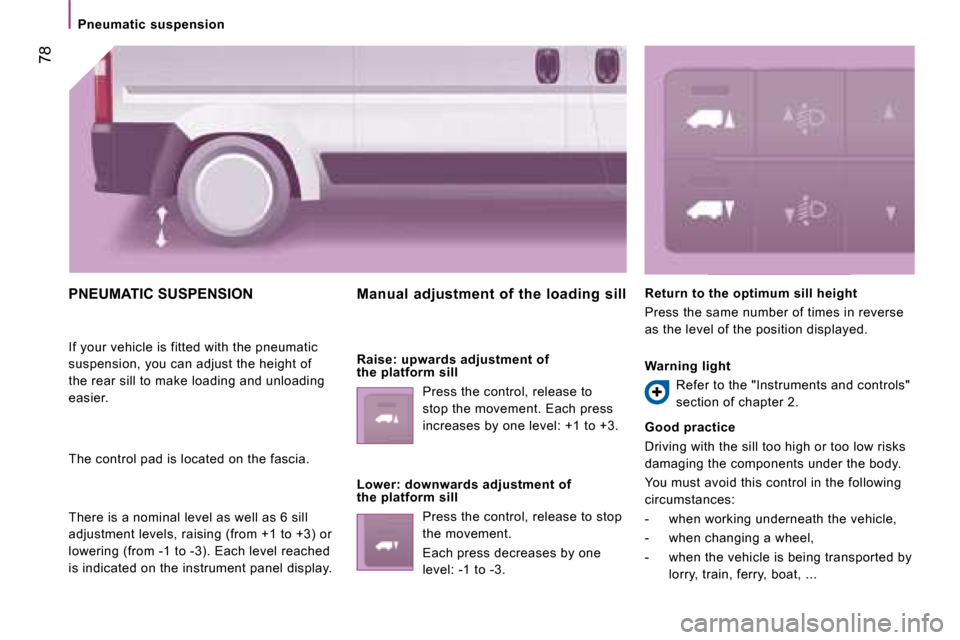
78
Pneumatic suspension
PNEUMATIC SUSPENSION
If your vehicle is fitted with the pneumatic
suspension, you can adjust the height of
the rear sill to make loading and unloading
easier.
The control pad is located on the fascia.
There is a nominal level as well as 6 sill
adjustment levels, raising (from +1 to +3) or
lowering (from -1 to -3). Each level reached
is indicated on the instrument panel display. Manual adjustment of the loading sill
Raise: upwards adjustment of
the platform sill
Press the control, release to
stop the movement. Each press
increases by one level: +1 to +3.
Lower: downwards adjustment of
the platform sill Press the control, release to stop
the movement.
Each press decreases by one
level: -1 to -3. Return to the optimum sill height
Press the same number of times in reverse
as the level of the position displayed.
Warning light
Refer to the "Instruments and controls"
section of chapter 2.
Good practice
Driving with the sill too high or too low risks
damaging the components under the body.
You must avoid this control in the following
circumstances:
- when working underneath the vehicle,
- when changing a wheel,
- when the vehicle is being transported by lorry, train, ferry, boat, ...
Page 88 of 163
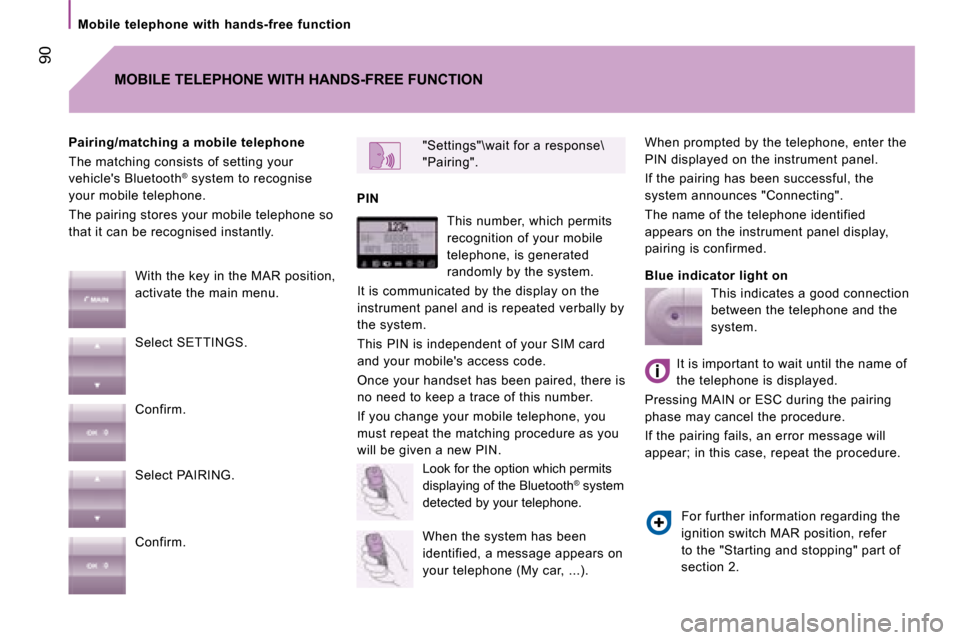
90
Mobile telephone with hands-free function
When prompted by the telephone, enter the
PIN displayed on the instrument panel.
If the pairing has been successful, the
system announces "Connecting".
The name of the telephone identified
appears on the instrument panel display,
pairing is confirmed.
Blue indicator light on
"Settings"\wait for a response\
"Pairing".
PIN
Pairing/matching a mobile telephone
The matching consists of setting your
vehicle's Bluetooth
®
system to recognise
your mobile telephone.
The pairing stores your mobile telephone so
that it can be recognised instantly. MOBILE TELEPHONE WITH HANDS-FREE FUNCTION
With the key in the MAR position,
activate the main menu.
Select SETTINGS.
Confirm.
Select PAIRING.
Confirm. This number, which permits
recognition of your mobile
telephone, is generated
randomly by the system.
It is communicated by the display on the
instrument panel and is repeated verbally by
the system.
This PIN is independent of your SIM card
and your mobile's access code.
Once your handset has been paired, there is
no need to keep a trace of this number.
If you change your mobile telephone, you
must repeat the matching procedure as you
will be given a new PIN. Look for the option which permits
displaying of the Bluetooth ®
system
detected by your telephone.
When the system has been
identified, a message appears on
your telephone (My car, ...). This indicates a good connection
between the telephone and the
system.
It is important to wait until the name of
the telephone is displayed.
Pressing MAIN or ESC during the pairing
phase may cancel the procedure.
If the pairing fails, an error message will
appear; in this case, repeat the procedure.
For further information regarding the
ignition switch MAR position, refer
to the "Starting and stopping" part of
section 2.
Page 98 of 163
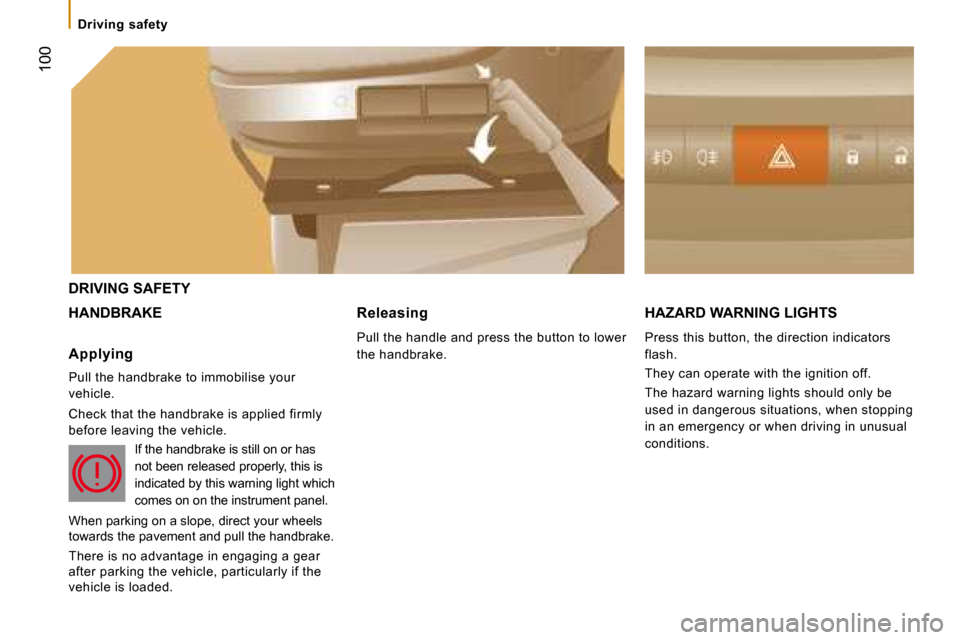
100
Driving safety
DRIVING SAFETY
HANDBRAKE HAZARD WARNING LIGHTS
Press this button, the direction indicators
flash.
They can operate with the ignition off.
The hazard warning lights should only be
used in dangerous situations, when stopping
in an emergency or when driving in unusual
conditions.
Applying
Pull the handbrake to immobilise your
vehicle.
Check that the handbrake is applied firmly
before leaving the vehicle.
If the handbrake is still on or has
not been released properly, this is
indicated by this warning light which
comes on on the instrument panel.
When parking on a slope, direct your wheels
towards the pavement and pull the handbrake.
There is no advantage in engaging a gear
after parking the vehicle, particularly if the
vehicle is loaded. Releasing
Pull the handle and press the button to lower
the handbrake.
Page 107 of 163
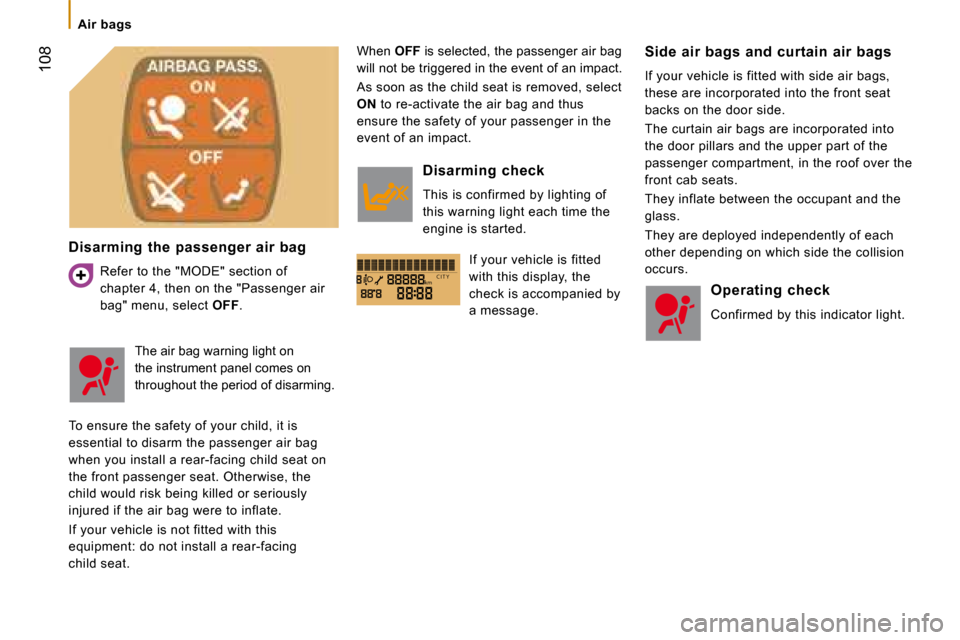
kmC I T Y
108
Air bags
Disarming the passenger air bag Refer to the "MODE" section of
chapter 4, then on the "Passenger air
bag" menu, select OFF . When
OFF is selected, the passenger air bag
will not be triggered in the event of an impact.
As soon as the child seat is removed, select
ON to re-activate the air bag and thus
ensure the safety of your passenger in the
event of an impact. Side air bags and curtain air bags
If your vehicle is fitted with side air bags,
these are incorporated into the front seat
backs on the door side.
The curtain air bags are incorporated into
the door pillars and the upper part of the
passenger compartment, in the roof over the
front cab seats.
They inflate between the occupant and the
glass.
They are deployed independently of each
other depending on which side the collision
occurs.
The air bag warning light on
the instrument panel comes on
throughout the period of disarming.
To ensure the safety of your child, it is
essential to disarm the passenger air bag
when you install a rear-facing child seat on
the front passenger seat. Otherwise, the
child would risk being killed or seriously
injured if the air bag were to inflate.
If your vehicle is not fitted with this
equipment: do not install a rear-facing
child seat. Disarming check
This is confirmed by lighting of
this warning light each time the
engine is started.
If your vehicle is fitted
with this display, the
check is accompanied by
a message. Operating check
Confirmed by this indicator light.
Page 109 of 163
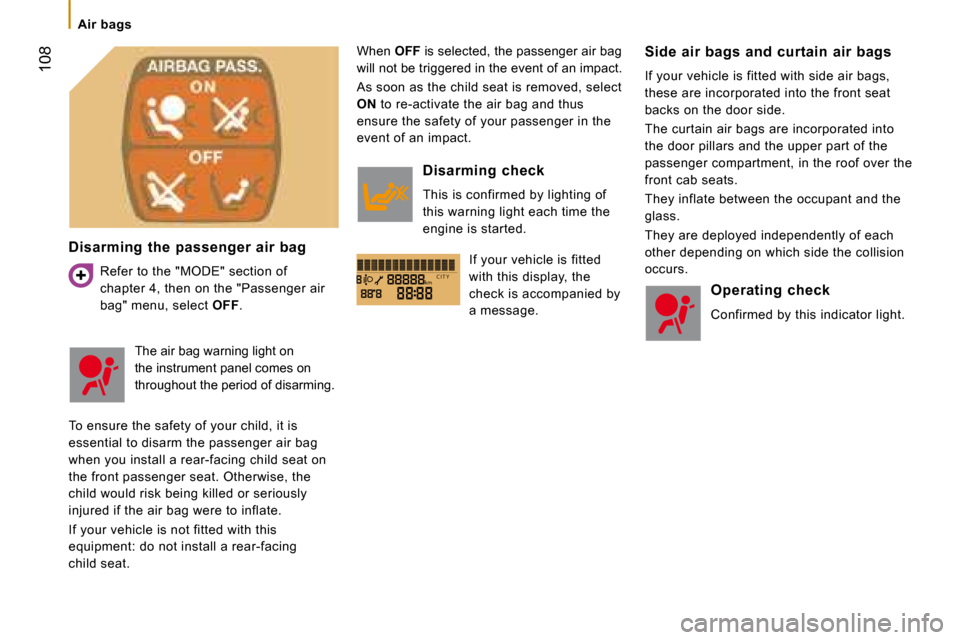
kmC I T Y
108
Air bags
Disarming the passenger air bag Refer to the "MODE" section of
chapter 4, then on the "Passenger air
bag" menu, select OFF . When
OFF is selected, the passenger air bag
will not be triggered in the event of an impact.
As soon as the child seat is removed, select
ON to re-activate the air bag and thus
ensure the safety of your passenger in the
event of an impact. Side air bags and curtain air bags
If your vehicle is fitted with side air bags,
these are incorporated into the front seat
backs on the door side.
The curtain air bags are incorporated into
the door pillars and the upper part of the
passenger compartment, in the roof over the
front cab seats.
They inflate between the occupant and the
glass.
They are deployed independently of each
other depending on which side the collision
occurs.
The air bag warning light on
the instrument panel comes on
throughout the period of disarming.
To ensure the safety of your child, it is
essential to disarm the passenger air bag
when you install a rear-facing child seat on
the front passenger seat. Otherwise, the
child would risk being killed or seriously
injured if the air bag were to inflate.
If your vehicle is not fitted with this
equipment: do not install a rear-facing
child seat. Disarming check
This is confirmed by lighting of
this warning light each time the
engine is started.
If your vehicle is fitted
with this display, the
check is accompanied by
a message. Operating check
Confirmed by this indicator light.
Page 123 of 163
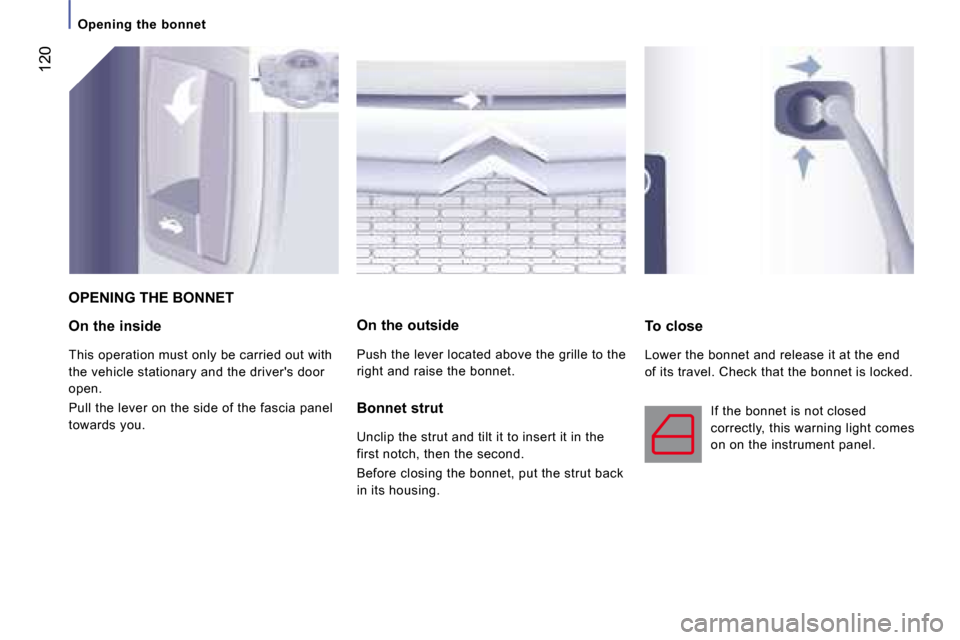
120
Opening the bonnet
On the inside
This operation must only be carried out with
the vehicle stationary and the driver's door
open.
Pull the lever on the side of the fascia panel
towards you.
On the outside
Push the lever located above the grille to the
right and raise the bonnet.
To close
Lower the bonnet and release it at the end
of its travel. Check that the bonnet is locked.
OPENING THE BONNET Bonnet strut
Unclip the strut and tilt it to insert it in the
first notch, then the second.
Before closing the bonnet, put the strut back
in its housing.
If the bonnet is not closed
correctly, this warning light comes
on on the instrument panel.
Page 125 of 163
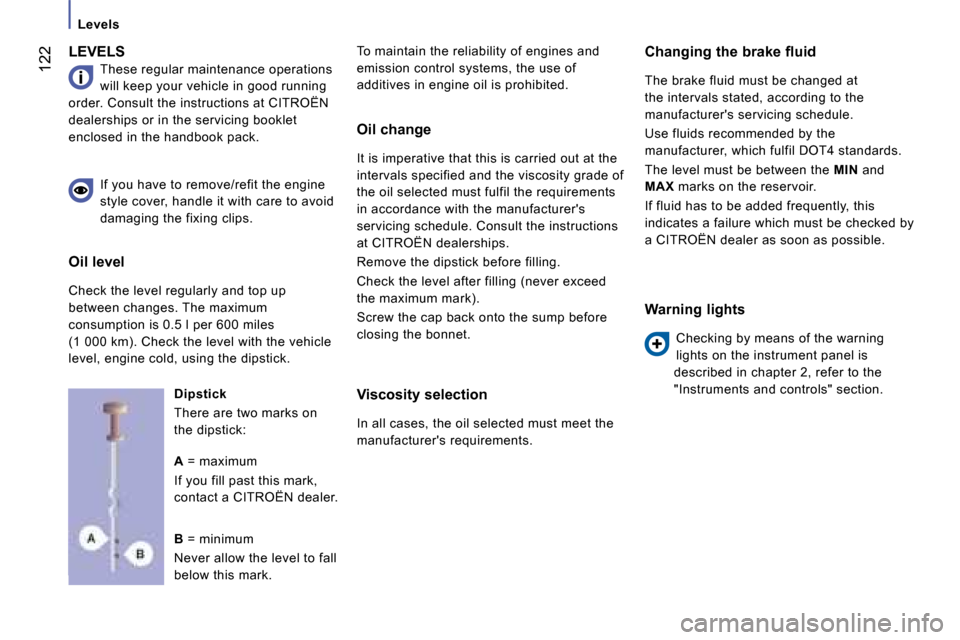
122
Levels
LEVELS These regular maintenance operations
will keep your vehicle in good running
order. Consult the instructions at CITROËN
dealerships or in the servicing booklet
enclosed in the handbook pack. To maintain the reliability of engines and
emission control systems, the use of
additives in engine oil is prohibited.
Changing the brake fluid
The brake fluid must be changed at
the intervals stated, according to the
manufacturer's servicing schedule.
Use fluids recommended by the
manufacturer, which fulfil DOT4 standards.
The level must be between the MIN and
MAX marks on the reservoir.
If fluid has to be added frequently, this
indicates a failure which must be checked by
a CITROËN dealer as soon as possible.
If you have to remove/refit the engine
style cover, handle it with care to avoid
damaging the fixing clips.
Dipstick
There are two marks on
the dipstick: Oil change
It is imperative that this is carried out at the
intervals specified and the viscosity grade of
the oil selected must fulfil the requirements
in accordance with the manufacturer's
servicing schedule. Consult the instructions
at CITROËN dealerships.
Remove the dipstick before filling.
Check the level after filling (never exceed
the maximum mark).
Screw the cap back onto the sump before
closing the bonnet.
Viscosity selection
In all cases, the oil selected must meet the
manufacturer's requirements.
Warning lights
Checking by means of the warning
lights on the instrument panel is
described in chapter 2, refer to the
"Instruments and controls" section.
A = maximum
If you fill past this mark,
contact a CITROËN dealer.
B = minimum
Never allow the level to fall
below this mark.
Oil level
Check the level regularly and top up
between changes. The maximum
consumption is 0.5 l per 600 miles
(1 000 km). Check the level with the vehicle
level, engine cold, using the dipstick.
Page 141 of 163
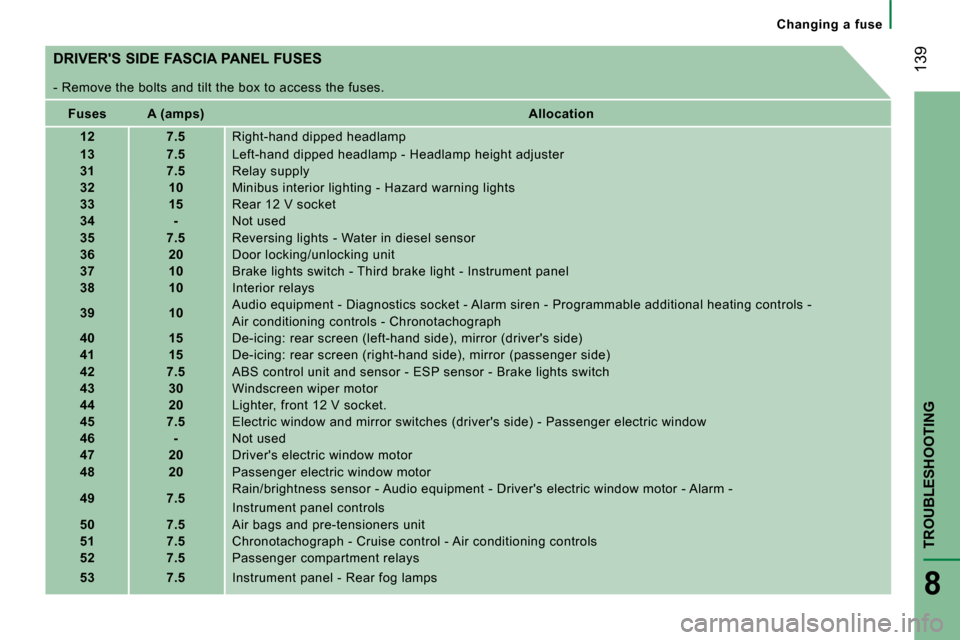
139
TROUBLESHOOTING
8
Changing a fuse
DRIVER'S SIDE FASCIA PANEL FUSES
- Remove the bolts and tilt the box to access the fuses.
Fuses A (amps)
Allocation
12 7.5 Right-hand dipped headlamp
13 7.5 Left-hand dipped headlamp - Headlamp height adj uster
31 7.5 Relay supply
32 10 Minibus interior lighting - Hazard warning ligh ts
33 15 Rear 12 V socket
34 - Not used
35 7.5 Reversing lights - Water in diesel sensor
36 20 Door locking/unlocking unit
37 10 Brake lights switch - Third brake light - Instr ument panel
38 10 Interior relays
39 10 Audio equipment - Diagnostics socket - Alarm siren
- Programmable additional heating controls -
Air conditioning controls - Chronotachograph
40 15 De-icing: rear screen (left-hand side), mirror (driver's side)
41 15 De-icing: rear screen (right-hand side), mirror (passenger side)
42 7.5 ABS control unit and sensor - ESP sensor - Brak e lights switch
43 30 Windscreen wiper motor
44 20 Lighter, front 12 V socket.
45 7.5 Electric window and mirror switches (driver's s ide) - Passenger electric window
46 - Not used
47 20 Driver's electric window motor
48 20 Passenger electric window motor
49 7.5 Rain/brightness sensor - Audio equipment - Driver'
s electric window motor - Alarm -
Instrument panel controls
50 7.5 Air bags and pre-tensioners unit
51 7.5 Chronotachograph - Cruise control - Air conditi oning controls
52 7.5 Passenger compartment relays
53 7.5 Instrument panel - Rear fog lamps